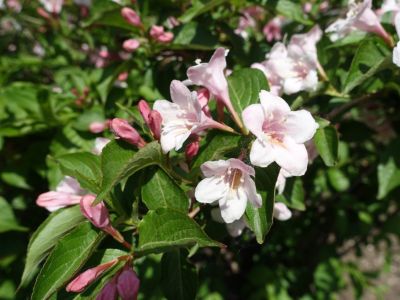Weigela Issues
Common problems with weigela include lack of blossoms, poor growth, foliage damage, and leaf yellowing. If an established shrub is not thriving like it once did, consider if the weigela plant care needs are being met. Check to see if the shrub was pruned at the correct time or if an unusually late frost has damaged new growth. Most importantly when you first notice problems with weigela, carefully check the shrub for signs of pests or disease. Catching these weigela issues at the onset can make the difference between saving or losing the shrub.
Weigela Insect Problems
Weigela are susceptible to a number of insect and pests whose feeding habits can damage foliage, leaving shrubs looking unsightly. Heavy infestations can also weaken and kill both young and established shrubs. These bugs constitute the most common weigela insect problems:
Aphids: These tiny insects can be found on the underside of leaves and stems. They secrete a sticky residue which attracts other insects. The injury they cause to plant tissue opens pathways for other infectious agents. Aphids cause foliage to yellow and curl. Four lined Plant Bugs: Four lined plant bugs are yellow and black striped bugs that hang out near the top of shrubs. Their damage causes irregular tan spots on the foliage. The nymph stage is orange or red with black spots.Japanese Beetles: Japanese beetles are medium sized, metallic green bugs. They consume leaves, giving them a lacy appearance.Leafroller: Leafrollers are little yellow worms that cause the foliage to curl and roll. The rolled leaves are often web filled.Mealybugs: These tiny insects can be identified by the fuzzy cotton masses found on the leaves, stems, and branches. Mealybugs cause yellowing of the leaves and reduction in plant vigor. Root Nematodes: These small worm like bugs infest the soil and feed on the roots. They are not easily identified unless the shrub is dug up and the roots are examined. Nematodes stunt plant growth and cause the leaves to turn reddish yellow. Scale: Identify tiny scale bugs by finding their small waxy scales attached to branches and leaves. They cause discoloration of upper leaf surfaces which results in leaf drop. Spider mites: These miniature red or black spider like bugs causes white dots and yellowing of leaves. Webbing is occasionally seen with spider mites. White flies: Easily identified by their large white wings, these flying insects cause leaves to turn yellow and fall. White flies can usually be found hiding on the underside of foliage.
Weigela Plant Diseases
Bacteria, fungus, and viruses are infectious agents which cause weigela plant diseases. Many diseases overwinter in plant debris or are spread from neighboring plants including weeds. For weigela plant diseases that have no cure, containing the infection or culling infected plants is often the only option. Here are several weigela plant diseases gardeners might find:
Anthracnose – Brown spots on leavesBlack Spot – Black spots on leavesBotrytis – Grey mold on stems, leaves, buds, and flowersCrown Galls – Swollen growths appearing where the roots meet the stemsPowdery Mildew – Curling leaves with whitish gray surfaceRoot Rot – Foliage turns yellow and drops. Plant can topple overRust – Reddish colored spots on leavesTwig Blight – Tips of the branches turn brown and die
